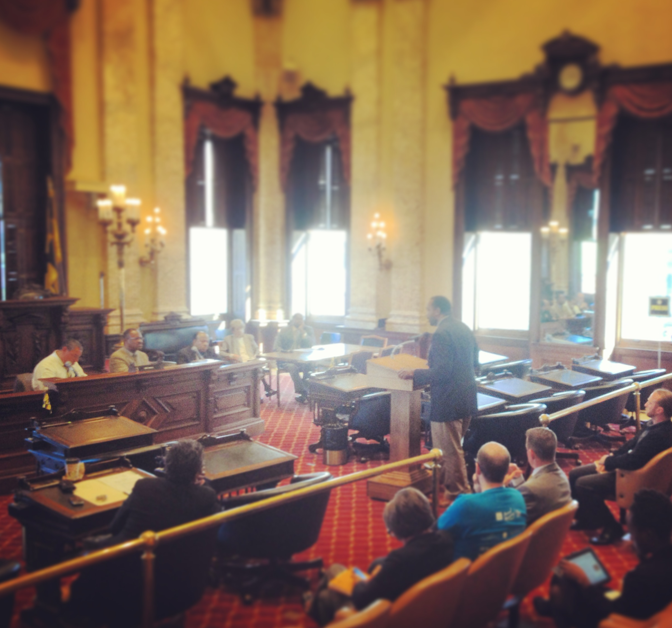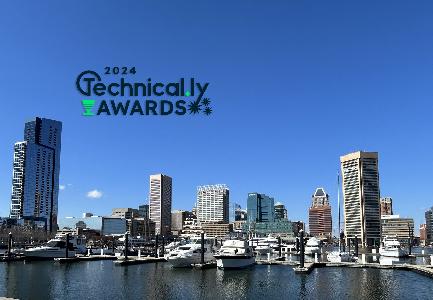It was like a first date. Find some common ground, mutual friends, share a little bit about yourself. So, like a first date, immediately after Baltimore City Council’s first ever hearing on the innovation economy, you wonder if anyone will call the other back to do something again.
To usher in a resolution officially making it “Baltimore Innovation Week” in Charm City, Baltimore City Council’s Community Development Committee listened to 90 minutes of testimony from a half dozen representatives of the region’s technology community.
The committee included chairman and District 4 councilman Bill Henry, District 7 Councilman Nick Mosby, Councilman Carl Stokes, Councilman Pete Welch and Councilwoman Mary Pat Clarke. In addition to other tech community members, representatives of the city’s IT office and Angela Gibson from the mayor’s office were in attendance at City Hall.

Participants in the Baltimore City Council Community Development hearing on the innovation economy including, from left, City Councilman Bill Henry, Council President Jack Young, who visited after the hearing, Digitall Systems founder Lance Lucas, Mindgrub Technologies CEO Todd Marks, Emerging Technology Centers director Deb Tillett, District 7 Councilman Nick Mosby, DiversiTech founder Christine Johnson, Digital Harbor Foundation cofounder Andrew Coy and Economic Alliance of Greater Baltimore director Tom Sadowski.
For both context and disclosure, Technical.ly Baltimore, which helped bring together Innovation Week, co-organized the hearing with staff of Councilman Mosby, who first introduced the resolution. The speakers included the following:
Inclusion by Christine Johnson of DiversiTech
“Tech communities are growing but do not reflect the cities they are in,” she said.
She also implored council to understand there are various efforts working on inclusion and improvement of the community. “Find and evaluate them all on a level playing field,” she said. She was referring to what she described as ‘New Baltimore’ needing to be embraced and find equal footing with what she called ‘Old Baltimore.’
There is new energy that needs to be welcomed, she said.
Early-stage tech startup support by Deb Tillett of the Emerging Technology Centers
Councilman Henry seemed impressed by Tillett’s describing of the ETC’s economic impact, which she used as a proxy for broader early stage growth. When she cited an economic footprint study that found that for every $1 of city funding to the ETC more than $180 has come back, Henry said: “that’s a far bigger impact than the Grand Prix,” the high-powered annual downtown IndyCar race event recently cancelled for next year.
“We focus economic development conversation on events, not on small business growth, which is strange,” said Henry of recent city precedent. Tillett’s other testimony included a rattling off of numbers around her tenure at the ETC:
- In 15 years, more than 300 companies have been incubated at one of the two facilities, 87 percent of which are still in operation, all of which are locatedin Maryland, half of which are in Baltimore city.
- Those companies account for more than 2,300 jobs at an average salary of $76,500 and have raised $1.5 billion in outside investment.
- A third of current ETC companies are minority or women owned.
- Of a $2.1 million budget in 2013, roughly a third comes from city funding, said Tillett.
Attraction and Retention by Todd Marks of Mindgrub Technologies
He’s outgrown his facilities in Catonsville and is looking for where to bring his company next — elsewhere in or near Baltimore County or into the city. The determining factors for him, Marks said, include city culture, tech ecosystem and the cost of doing business. He said the public school system was a major reason why he hesitates to bring his company to Baltimore city, fearing his employees won’t want to send their kids to the beleaguered urban district and so will face a longer work commute.
That prompted a lengthy exchange between Marks and Councilwoman Clarke, saying she had put her kids successfully through Baltimore city schools years ago and perception was more the problem than the reality. Marks and others should help change that, she said.
“It’s not just money, it’s not just marketing, it’s participating,” she said to Marks.
Marks said he’s interested in the Locust Point area and being near to Under Armour, as the publicly traded company continues to build out the area with development going to residential support. Those pockets of a development, particularly if there was the perception of school choice, are a real promise for the city, Marks said.
Preparing Baltimore city youth by Andrew Coy of the Digital Harbor Foundation
“We need to rethink what the rec center can be,” Coy said, noting that city rec centers were built in the Industrial Age to offer extended day care for second shift industrial workers. “We need new skills now.”
His Rec2Tech Center that replaced last year the South Baltimore recreation center near Cross Street, near the school where he formerly served, Digital Harbor High School, has been regular fodder for what new youth engagement can be. That excited Clarke, who wants to visit with Councilman Stokes, and should have also caught Councilman Henry’s ear, as he’s pushed for the future of rec centers.
Creating an IT jobs pipeline by Lance Lucas of DigitAll Systems
Though Coy dismissed certification programs as dated, Lucas still sees them as a vital part of the pipeline for young Baltimore city residents to show they are prepared for IT jobs at existing companies. Lucas shared how his program has placed a wide range of Baltimore city residents in stable IT jobs.
IT’s role in the region’s economy by Tom Sadowski of the Economic Alliance of Greater Baltimore
Technology is a serious part of the growth strategy for the Baltimore region’s business community, Sadowski said. The $42 billion cybersecurity market, a healthcare tech sector growing out of Johns Hopkins and strong edtech roots are ways to show a clear regional distinction.

So what comes next? The resolution will be introduced to the rest of council on Oct. 7, said Henry, and Coy plans to follow up with Clarke and Stokes about having them visit his space. Henry, too, seemed to be mulling more seriously an economic strategy with technology and small business growth in mind. Several of the council representatives wanted to hear more about how Marks would choose his next offices.
They are small steps toward better understanding. But, like a first date, growing a more serious relationship takes considerable commitment.
Before you go...
Please consider supporting Technical.ly to keep our independent journalism strong. Unlike most business-focused media outlets, we don’t have a paywall. Instead, we count on your personal and organizational support.
Join our growing Slack community
Join 5,000 tech professionals and entrepreneurs in our community Slack today!





